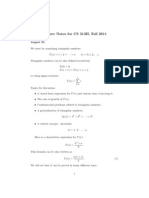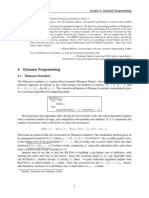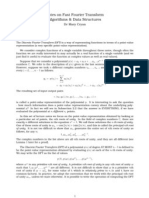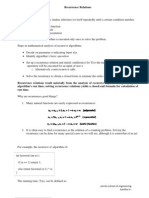Recursion
Recursion
Uploaded by
Piron LiveCopyright:
Available Formats
Recursion
Recursion
Uploaded by
Piron LiveOriginal Title
Copyright
Available Formats
Share this document
Did you find this document useful?
Is this content inappropriate?
Copyright:
Available Formats
Recursion
Recursion
Uploaded by
Piron LiveCopyright:
Available Formats
Recursion
The recursive function is
– a kind of function that calls itself, or
– a function that is part of a cycle in the sequence of function calls.
f1 f1 f2 … fn
Let’s we want to find the factorial of a number: f(n) = n! We know that
n! = 1 * 2 * 3 * … * (n – 1) * n
For example, f(5) = 1 * 2 * 3 * 4 * 5. We also know that f(4) = 1 * 2 * 3 * 4. So
f(5) = (1 * 2 * 3 * 4) * 5 = f(4) * 5
The problem of calculating f(5) is reduced to the problem of calculating f(4): in
order to find f(5) we first must find f(4) and then multiply the result by 5. This process
can be continues like
f(5) = f(4) * 5 = f(3) * 4 * 5 = f(2) * 3 * 4 * 5 = …
How long shall we continue this process? We know that 0! = 1, but there is no
sense for calculating factorial for negative numbers. The equality 0! = 1 or f(0) = 1 is
called simple case or terminating case or base case. When we need to find f(0), we do
not continue the reduction like f(0) = f(-1) * 0 because it has no sense, but simply
substitute the value of f(0) by 1. So
f(2) = f(1) * 2 = f(0) * 1 * 2 = 1 * 1 * 2 = 2
A recursive function consists of two types of cases:
a base case(s)
a recursive case
The base case is a small problem
the solution to this problem should not be recursive, so that the function is
guaranteed to terminate
there can be more than one base case
The recursive case defines the problem in terms of a smaller problem of the same
type
the recursive case includes a recursive function call
there can be more than one recursive case
From the definition of factorial we can conclude that
n! = (1 * 2 * 3 * … * (n – 1)) * n = (n – 1)! * n
If we denote f(n) = n! then f(n) = f(n – 1) * n. This is called recursive case. We
continue the recursive process till n = 0, when 0! = 1. So f(0) = 1. This is called the base
case.
f(3) = f(2) * 3
f(1) * 2
1*1*2*3 = 6
f(0) * 1
1
f (n) f (n 1) * n recursive case
f (0) 1 base case
E-OLYMP 1658. Factorial For the given number n find the factorial n!
► The problem can be solved with for loop, but we’ll consider the recursive
solution. To solve the problem, simply call a function fact(n). The value n ≤ 20, use
long long type.
long long fact(int n)
{
if (n == 0) return 1;
return fact(n-1) * n;
}
E-OLYMP 1603. The sum of digits Find the sum of digits of an integer.
► Input number n can be negative. In this case we must take the absolute value of
it (sum of digits for -n and n is the same).
Let sum(n) be the function that returns the sum of digits of n.
If n < 10, the sum of digits equals to the number itself: sum(n) = n;
Otherwise we add the last digit of n to sum(n / 10);
We have the following recurrence relation:
sum (n / 10 ) n%10, n 10
sum(n) =
n, n 10
sum(123) = sum(12) +3 = sum(1) +2 +3 = 1 +2 +3 = 6
E-OLYMP 2. Digits Find the number of digits in a nonnegative integer n.
► Let digits(n) be the function that returns the number of digits of n. Note that
sum of digits for n = 0 equals to 1.
If n < 10, the number of digits equals to 1: digits(n) = 1;
Otherwise we add 1 to digits(n / 10);
We have the following recurrence relation:
digits (n / 10 ) 1, n 10
digits(n) =
1, n 10
Example: digits(246) = digits(24) + 1 = digits(2) + 1 + 1 = 1 + 1 + 1 = 3.
E-OLYMP 3258. Fibonacci Sequence The Fibonacci sequence is defined as
follows:
a0 = 0
a1 = 1
ak = ak-1 + ak-2
For a given value of n find the n-th element of Fibonacci sequence.
► In the problem you must find the n-th Fibonacci number. For n ≤ 40 the
recursive implementation will pass time limit. The Fibonacci sequence has the
following form:
i 0 1 2 3 4 5 6 7 8 9 10 ...
fi 0 1 1 2 3 5 8 13 21 34 55 ...
The biggest Fibonacci number that fits into int type is
f46 = 1836311903
For n ≤ 40 its enough to use type int.
Let fib(n) be the function that returns the n-th Fibonacci number. We have the
following recurrence relation:
fib(n 1) fib(n 2), n 1
fib(n) = 1, n 1
0, n 0
int fib(int n)
{
if (n == 0) return 0;
if (n == 1) return 1;
return fib(n-1) + fib(n - 2);
}
You might also like
- 12v DC To220v Ac Inverter ReportDocument35 pages12v DC To220v Ac Inverter Reportabhishek kalshetti100% (5)
- Session 24: Recursion and Recurrence RelationsDocument19 pagesSession 24: Recursion and Recurrence RelationsNalam AshikaNo ratings yet
- Cambridge English Empower A1 Speaking Competency Test Mid-Course Test Materials For TeachersDocument3 pagesCambridge English Empower A1 Speaking Competency Test Mid-Course Test Materials For TeachersMelissa Ruiz RojasNo ratings yet
- Solutions of RDBMSDocument64 pagesSolutions of RDBMSAkshay MehtaNo ratings yet
- Chapter 3: Recursion, Recurrence Relations, and Analysis of AlgorithmsDocument23 pagesChapter 3: Recursion, Recurrence Relations, and Analysis of AlgorithmsCLNo ratings yet
- ADA PresentationDocument6 pagesADA PresentationSamriddhi JainNo ratings yet
- 268 L2 Recursion S09Document29 pages268 L2 Recursion S09yoursashmeNo ratings yet
- Recursion 111Document11 pagesRecursion 111حسن بوحواNo ratings yet
- FiboDocument18 pagesFiboIvan MetalnikovNo ratings yet
- Lecture Notes For CS 313H, Fall 2011Document21 pagesLecture Notes For CS 313H, Fall 2011cynthiangel007No ratings yet
- FibonacciDocument3 pagesFibonacciPiron LiveNo ratings yet
- 18.312 Algebraic Combinatorics: Mit OpencoursewareDocument6 pages18.312 Algebraic Combinatorics: Mit OpencoursewarebmandarNo ratings yet
- Dynamic ProgrammingDocument30 pagesDynamic Programmingdevchakraborty9914No ratings yet
- Data Structures and Algorithms: RecursionDocument27 pagesData Structures and Algorithms: RecursionSaksham SharmaNo ratings yet
- DP 1Document12 pagesDP 1KARTIKEY GARGNo ratings yet
- Recursion 1Document15 pagesRecursion 1GAUTAM JHANo ratings yet
- DP 1673149461Document30 pagesDP 1673149461abhi hayerNo ratings yet
- Chapter 05 RecursionDocument18 pagesChapter 05 Recursionasdyarash1No ratings yet
- Algorithms Lecture 4: Dynamic ProgrammingDocument15 pagesAlgorithms Lecture 4: Dynamic ProgrammingAnirban ChowdhuryNo ratings yet
- Alg Ch1 Part2Document24 pagesAlg Ch1 Part2yarajehadrabNo ratings yet
- Discrete MathematicsDocument45 pagesDiscrete MathematicsDilip KdNo ratings yet
- CS 321-Analysis of Algorithms: Instructor: Asim RehanDocument30 pagesCS 321-Analysis of Algorithms: Instructor: Asim RehanSyed Jarar Ali BukhariNo ratings yet
- Recursive DefinitionsDocument18 pagesRecursive DefinitionsgbikornoNo ratings yet
- Introduction To Programming in PythonDocument4 pagesIntroduction To Programming in Pythonitsabhi027No ratings yet
- Recursive ProblemsDocument11 pagesRecursive ProblemsIonut NegreaNo ratings yet
- Math 328 Module 1 Fourier SeriesDocument26 pagesMath 328 Module 1 Fourier SeriesMelchor Jaramilla OronosNo ratings yet
- Analysis of Order 4 Sequences: Faculty Research FairDocument3 pagesAnalysis of Order 4 Sequences: Faculty Research FairJulius Fergy RabagoNo ratings yet
- Chapter 4 - RecursionDocument31 pagesChapter 4 - Recursionmtdeptrai430No ratings yet
- 2 Dynamic Programming (September 5 and 10) : 2.1 Exponentiation (Again)Document14 pages2 Dynamic Programming (September 5 and 10) : 2.1 Exponentiation (Again)Hemesh SinghNo ratings yet
- Sequence: Mathematics (Sequence and Series)Document3 pagesSequence: Mathematics (Sequence and Series)SatishNo ratings yet
- MAT2A10Lecture1 SequenceDocument15 pagesMAT2A10Lecture1 SequenceSamuel KhibaNo ratings yet
- Dynamic Programming: CSE 301: Combinatorial OptimizationDocument45 pagesDynamic Programming: CSE 301: Combinatorial Optimizationswarna islamNo ratings yet
- ArithmeticDocument17 pagesArithmeticRose Eden AbitongNo ratings yet
- IntroductionDocument18 pagesIntroductionxcygonNo ratings yet
- 1 The Euler Phi FunctionDocument19 pages1 The Euler Phi FunctionRico LeeNo ratings yet
- Notes On Fast Fourier Transform Algorithms & Data StructuresDocument11 pagesNotes On Fast Fourier Transform Algorithms & Data Structures"The Dangerous One"No ratings yet
- Sequences of Functions - Pointwise and Uniform ConvergenceDocument5 pagesSequences of Functions - Pointwise and Uniform ConvergencezanibabNo ratings yet
- RecursionDocument17 pagesRecursionMsc BscNo ratings yet
- Cameron 2017 Chap1Document11 pagesCameron 2017 Chap1tonidescargaNo ratings yet
- Lecture No 3: CS-302 Design and Analysis of AlgorithmsDocument26 pagesLecture No 3: CS-302 Design and Analysis of AlgorithmsTanveer ZafarNo ratings yet
- CS201: Discrete Mathematics Semester II, 2010-11, CSE, IIT Kanpur Lecture 8 (14 January)Document4 pagesCS201: Discrete Mathematics Semester II, 2010-11, CSE, IIT Kanpur Lecture 8 (14 January)Manoj NanduriNo ratings yet
- Problem Set 1 SolutionsDocument9 pagesProblem Set 1 SolutionsRohan BhargavNo ratings yet
- LAL Lecture NotesDocument73 pagesLAL Lecture NotesAnushka VijayNo ratings yet
- Power Series SolutionsDocument45 pagesPower Series SolutionsJosamy MartinezNo ratings yet
- 12 RecursionDocument25 pages12 RecursionSatyender Rahul MishraNo ratings yet
- DAA Unit-3 (A)Document65 pagesDAA Unit-3 (A)rushilpatel210210No ratings yet
- NotesDocument9 pagesNoteshob hobberstonNo ratings yet
- AMT-2b. Recursively Defined FunctionsDocument2 pagesAMT-2b. Recursively Defined FunctionsManish kumawatNo ratings yet
- Relations: 3. Recursive Algorithms and RecurrenceDocument28 pagesRelations: 3. Recursive Algorithms and RecurrenceNagasuri Bala VenkateswarluNo ratings yet
- 12.04.dynamic ProgrammingDocument97 pages12.04.dynamic Programmingcurtisandrea242No ratings yet
- DP LinearDocument14 pagesDP Linearsultanovsubhan50No ratings yet
- 3 - Recursive Function.Document3 pages3 - Recursive Function.ApoyyyNo ratings yet
- 6128ed8867806corrige Maths Its B Option Economie 2008 EnseaDocument4 pages6128ed8867806corrige Maths Its B Option Economie 2008 Enseasowb1960No ratings yet
- CSCI 235 Section 3/4 - Spring 2015 More Recursion: 1 ExamplesDocument5 pagesCSCI 235 Section 3/4 - Spring 2015 More Recursion: 1 ExamplesAshley GittensNo ratings yet
- Recursion C++Document39 pagesRecursion C++MateoCaCeNo ratings yet
- 3-Correctness of algorithmsDocument19 pages3-Correctness of algorithmssahooabhijit5442No ratings yet
- A Generalization of The Cassini Formula: Alexey StakhovDocument6 pagesA Generalization of The Cassini Formula: Alexey Stakhov1111qwerasdfNo ratings yet
- Recurrence Relations PDFDocument8 pagesRecurrence Relations PDFGunjan AgarwalNo ratings yet
- Riemann's Paper 2Document2 pagesRiemann's Paper 2Uninvited GuestNo ratings yet
- Functional Operators, Volume 2: The Geometry of Orthogonal SpacesFrom EverandFunctional Operators, Volume 2: The Geometry of Orthogonal SpacesNo ratings yet
- FibonacciDocument3 pagesFibonacciPiron LiveNo ratings yet
- Fitzsimons IndusValleyCivilization 1970Document15 pagesFitzsimons IndusValleyCivilization 1970Piron LiveNo ratings yet
- LawsofUr Nammu v3Document16 pagesLawsofUr Nammu v3Piron LiveNo ratings yet
- Hello WorldDocument19 pagesHello WorldPiron LiveNo ratings yet
- Cin CoutDocument1 pageCin CoutPiron LiveNo ratings yet
- New Digital Qs ClassDocument18 pagesNew Digital Qs ClassPiron LiveNo ratings yet
- Sat Practice Test 3 DigitalDocument56 pagesSat Practice Test 3 DigitalPiron Live100% (1)
- March StudentsDocument14 pagesMarch StudentsPiron LiveNo ratings yet
- Sat Practice Test 1 DigitalDocument56 pagesSat Practice Test 1 Digitallucifer morningstarNo ratings yet
- Baldo (2015) The Effect of Different Genres of Music On The Growth of Radish Plant (Raphanus Sativus)Document66 pagesBaldo (2015) The Effect of Different Genres of Music On The Growth of Radish Plant (Raphanus Sativus)StiltonNo ratings yet
- The Inner Planets Worksheet: A. Find The Answers To The Following Questions. Write Them On The Lines ProvidedDocument10 pagesThe Inner Planets Worksheet: A. Find The Answers To The Following Questions. Write Them On The Lines ProvidedAllen Rey YeclaNo ratings yet
- RK Singla's BS XII Worksheet 1Document10 pagesRK Singla's BS XII Worksheet 1shubham kumar33% (6)
- Digital Album of Social ScientistsDocument22 pagesDigital Album of Social ScientistsichayanNo ratings yet
- Rogue Trader RulesDocument230 pagesRogue Trader RulesKyle Hamilton-LeckyNo ratings yet
- Git Essentials - Sample ChapterDocument16 pagesGit Essentials - Sample ChapterPackt PublishingNo ratings yet
- Multilink NDocument5 pagesMultilink NRina permata sariNo ratings yet
- Modal Vs Functional Harmony + Various Q&A About ModesDocument25 pagesModal Vs Functional Harmony + Various Q&A About ModesAnonymous TBwEsioW100% (1)
- Mir For Aluminium LadderDocument13 pagesMir For Aluminium LadderRoshan George PhilipNo ratings yet
- BMW Installation Instructions - Rear Footrests - 02.2021Document7 pagesBMW Installation Instructions - Rear Footrests - 02.2021aviaqualNo ratings yet
- Empowerment Technologies: Quarter 2 - Module 11: Research Content For Social Advocacy in Developing An ICT ProjectDocument20 pagesEmpowerment Technologies: Quarter 2 - Module 11: Research Content For Social Advocacy in Developing An ICT ProjectArlene Flor100% (1)
- Paper PDFDocument19 pagesPaper PDFrajeshNo ratings yet
- Salary SlipDocument1 pageSalary Sliprichard parkerNo ratings yet
- Peter Swirski - From Literature To Biterature - Lem, Turing, Darwin, and Explorations in Computer Literature, Philosophy of Mind, and Cultural Evolution-Mcgill Queens University Press (2013)Document244 pagesPeter Swirski - From Literature To Biterature - Lem, Turing, Darwin, and Explorations in Computer Literature, Philosophy of Mind, and Cultural Evolution-Mcgill Queens University Press (2013)Alejandro Del VecchioNo ratings yet
- Business Studies PDFDocument196 pagesBusiness Studies PDFvineet ButolaNo ratings yet
- Cambridge International A Level: Mathematics 9709/61 May/June 2021Document13 pagesCambridge International A Level: Mathematics 9709/61 May/June 2021Oyunnomin BatmyagmarNo ratings yet
- Soal Ujian Semstr Ganjil 2017-2018Document19 pagesSoal Ujian Semstr Ganjil 2017-2018Afriadi A. PalasongNo ratings yet
- Naskah Publikasi (Yuli Kurniasih)Document11 pagesNaskah Publikasi (Yuli Kurniasih)Dadang UbaedillahNo ratings yet
- TFG - Noelia RodriguezDocument23 pagesTFG - Noelia RodriguezCamila FreireNo ratings yet
- Ra 10530Document7 pagesRa 10530mich3300No ratings yet
- Thewordsearch-Com-Cultural-Activities-5747223 2Document1 pageThewordsearch-Com-Cultural-Activities-5747223 2ByeNo ratings yet
- Topic 2 BMGT 111-Business Environment Topic 2Document18 pagesTopic 2 BMGT 111-Business Environment Topic 2Lynne Wangare100% (1)
- LO-006A - Certificate of Course CompletionDocument15 pagesLO-006A - Certificate of Course Completionkumar kartikeyaNo ratings yet
- Bangladesh Army University of Engineering & Technology (BAUET)Document2 pagesBangladesh Army University of Engineering & Technology (BAUET)Rony sahaNo ratings yet
- 10 - Relative Clauses - PracticeDocument2 pages10 - Relative Clauses - PracticeSantosNo ratings yet
- Module 6Document21 pagesModule 6Leonora CidNo ratings yet
- Suresh Naphade ComputationDocument2 pagesSuresh Naphade ComputationSAURABH KULKARNINo ratings yet
































































































